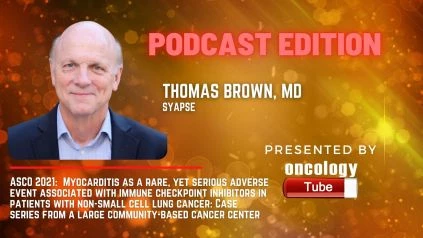Thomas Brown, MD, Chief Medical Officer, Syapse speaks about ASCO 2021 Abstract – #e21047 – Myocarditis as a rare, yet serious adverse event associated with immune checkpoint inhibitors in patients with non-small cell lung cancer: Case series from a large community-based cancer center.
Link to Abstract:
https://meetinglibrary.asco.org/record/200926/abstract
Background:
Immune checkpoint inhibitors (ICI) may cause immune-related adverse effects in patients with lung cancer and other malignancies (irAE). Pneumonitis, colitis, hepatitis, and myocarditis/pericarditis can all manifest with varying degrees of severity and single- or multi-organ involvement. Myocarditis occurs in 0.06 percent to 2.4 percent of the population and is associated with a significant death rate (25 percent to 50 percent ). Myocarditis is a high-grade adverse event in patients with lung cancer treated with ICIs is investigated in this retrospective evaluation of real-world data (RWD).
Methods:
From 2010 through 2020, Advocate Aurora Health Care used RWD to identify and classify patients on the Syapse Learning Health Network platform. Patients had to be at least 18 years old, have histologically proven NSCLC, and have a diagnosis of myocarditis based on ICD codes. A second chart check was carried out to corroborate the date of the ICI therapy and the onset of myocarditis. After IRB approval, all pts were identified and reviewed.
Results:
The study included 12,686 patients with non-small cell lung cancer. The median age at diagnosis was 70; 54 percent of the patients were female; 86 percent were white and 12 percent were Black; 1,975 (15.6 percent) were treated with an ICI, and four incidences of myocarditis were discovered among them (0.2 percent). All four points were White females between the ages of 46, 59, 65, and 74. Lung adenocarcinoma (3) and an undifferentiated lung carcinoma were found on pathology (1). All of the patients had a metastatic illness, and none of them had a history of heart problems. Pembrolizumab (2), durvalumab (1), and nivolumab were the ICIs (1). The median period from the first dosage of ICI to myocarditis diagnosis was 62 days [range: 42-185]. All four patients had chest discomfort and high troponin T levels (median 0.07 ng/ml, range 0.06-0.08). At the time of diagnosis, all of the patients received an echocardiogram, and two of them received a cardiac MRI that confirmed myocarditis. Three patients were given a prednisone taper. Despite high dosage corticosteroids, one patient died of recurrent congestive heart failure and ventricular tachycardia. Concomitant irAEs of hypothyroidism/colitis and thyroiditis/pneumonitis were found in two patients.
Conclusions:
Many of the irAEs can be reversed. Clinically visible myocarditis is an uncommon but dangerous side effect of ICI treatment, according to RWD research. Poor outcomes can be avoided by early consideration, diagnosis, and action. The current standard of care is to stop using ICIs and start taking corticosteroids. More study is needed to better identify high-risk individuals, develop monitoring techniques, and enhance ICI-associated myocarditis therapy.

